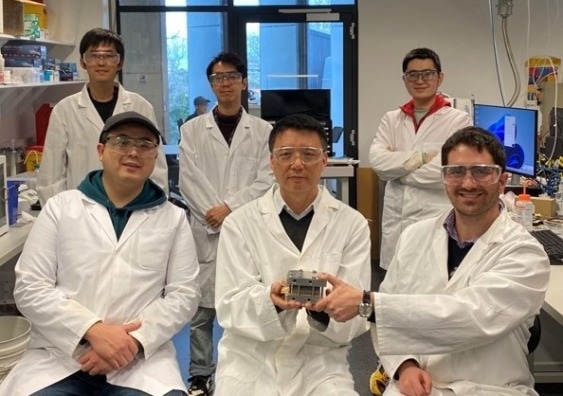Hydrogen is a crucial element in solving the clean energy puzzle, a challenge that experts tackling the energy transition are eager to overcome in order to reduce carbon emissions. When hydrogen is used as fuel, it produces only electricity, heat, and water,1 regardless of whether it is used for everyday gadgets or large-scale power plants.

Image Credit: UNSW
However, there are significant limitations to hydrogen fuel cell technologies. These include issues with stability, low energy densities, and inefficient discharge, as well as problems related to degradation, cost, and the capacity to store hydrogen within fuel cell systems.2
To address these challenges, a group of researchers from the University of New South Wales (UNSW) in Sydney has set out to develop a new technique for analyzing and enhancing the stability of hydrogen fuel cells.
The goal is to create more durable fuel cells that can tackle stability and degradation problems, ultimately reducing long-term costs and prompting innovations in more efficient fuel cell production.
The Road to Sustainable Energy
Hydrogen fuel cells produce electricity and heat by leveraging the chemical energy of hydrogen, leaving behind water as the only byproduct. This is accomplished by feeding hydrogen fuel into the cell’s anode, where a catalyst breaks it down into protons and electrons.
Unlike battery technology, fuel cells do not need to be recharged and will operate as long as a steady supply of fuel is provided. This characteristic grants hydrogen fuel cells an extended operational lifespan. Moreover, they possess a lighter and more compact design, which has the potential to yield greater power outputs when integrated into automotive systems.
However, hydrogen fuel cells remain relatively high in cost due to the fact they use platinum, a precious rare earth metal, as the catalyst. This has, in turn, led to a slower uptake of this type of fuel cell, meaning commercial success is still some way off.
Platinum is always going to be expensive, because there isn’t a lot out there… So, we need to explore alternatives, whilst also providing a quick and easy way to measure how well these new materials are working in hydrogen fuel cells.
Professor Chuan Zhao, UNSW
This pursuit of innovative catalyst solutions and continuous improvement reflects the team's determination to carve a path toward a more sustainable energy landscape.
A Catalyst for Change
The UNSW team, led by Professor Chuan Zhao, Dr. Quentin Meyer, and Mr. Shiyang Liu from the School of Chemistry, is trying to improve hydrogen fuel cell technology by finding a way to develop alternative platinum-free catalysts. In doing so, the team believes that they can significantly enhance the commercial feasibility of hydrogen fuel cells.
However, the challenge is not simply about finding a substitute material; it is about making sure that any new materials can match or exceed the existing materials in terms of functionality and stability.
The UNSW researchers concentrated on pinpointing when iron demetallation and carbon corrosion take place. These factors contribute to the increased susceptibility of platinum-free catalysts to degradation in hydrogen fuel cells.3
Using three novel methods that we tested in the lab, we can quickly figure out how stable our platinum-free fuel cell is and most importantly understand why. This approach can be easily adopted by scientists in other labs to gain quick and accurate insights into the efficiency of their fuel cells and catalysts.
Professor Chuan Zhao, UNSW
In essence, the UNSW team’s multifaceted endeavor, ranging from catalyst exploration to innovative evaluation techniques, stands as a catalyst for progress in the realm of sustainable energy.
A Path to Enhanced Stability
The team revealed that this technique enabled them to precisely identify sites susceptible to activity loss in platinum-free catalysts, a factor contributing to the accelerated degradation during operation. By identifying and addressing this issue, the team believes that they could then directly implement measures aimed at mitigating adverse impacts within the fuel cell system.
By allowing precise tracking of the degradation mechanisms, we expect that the research field will be able to make new materials targeting these stability issues. As a result, we believe our approach will help improve the stability of platinum-free catalysts and give this field a brighter future.
Dr. Quentin Meyer, UNSW
The UNSW team has shown that by improving the analysis techniques to improve hydrogen fuel cell stability issues, others working to find platinum-free catalysts for use in fuel cells will be better equipped at identifying and creating alternative materials.
By extension, this promising breakthrough will help to usher in a future where hydrogen fuel cells could take center stage on the commercial scale, spanning diverse applications from power plants to transportation solutions.
Beyond fortifying the hydrogen energy economy, this achievement potentially propels us closer to a cleaner and more sustainable energy landscape. Moreover, this research, in part, responds to the imperative of embracing hydrogen as a worldwide energy solution, given the ongoing drive to reduce global carbon emissions.4
References and Further Reading
-
Fuel cells (2023) Energy.gov. Available at: https://www.energy.gov/eere/fuelcells/fuel-cells (Accessed: 15 August 2023).
-
Iea (2023) The future of hydrogen – analysis, IEA. Available at: https://www.iea.org/reports/the-future-of-hydrogen (Accessed: 15 August 2023).
-
Liu, S. et al. (2023) ‘operando deconvolution of the degradation mechanisms of iron–nitrogen–carbon catalysts in proton exchange membrane fuel cells’, Energy & Environmental Science. Available at: https://pubs.rsc.org/en/content/articlelanding/2023/ee/d3ee01166f.
-
Why hydrogen (2022) Hydrogen Council. Available at: https://hydrogencouncil.com/en/why-hydrogen/. (Accessed: 15 August 2023).
Disclaimer: The views expressed here are those of the author expressed in their private capacity and do not necessarily represent the views of AZoM.com Limited T/A AZoNetwork the owner and operator of this website. This disclaimer forms part of the Terms and conditions of use of this website.